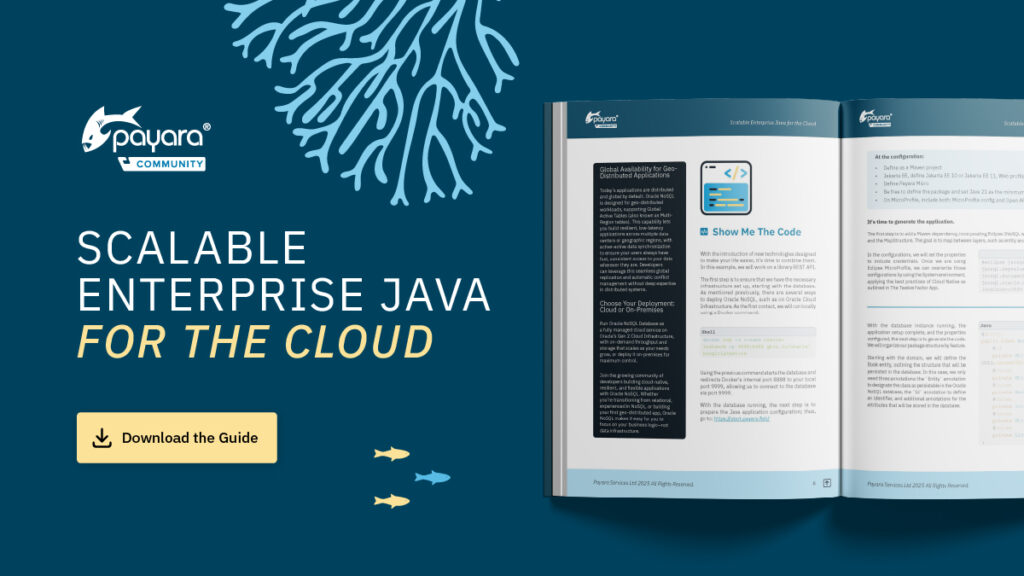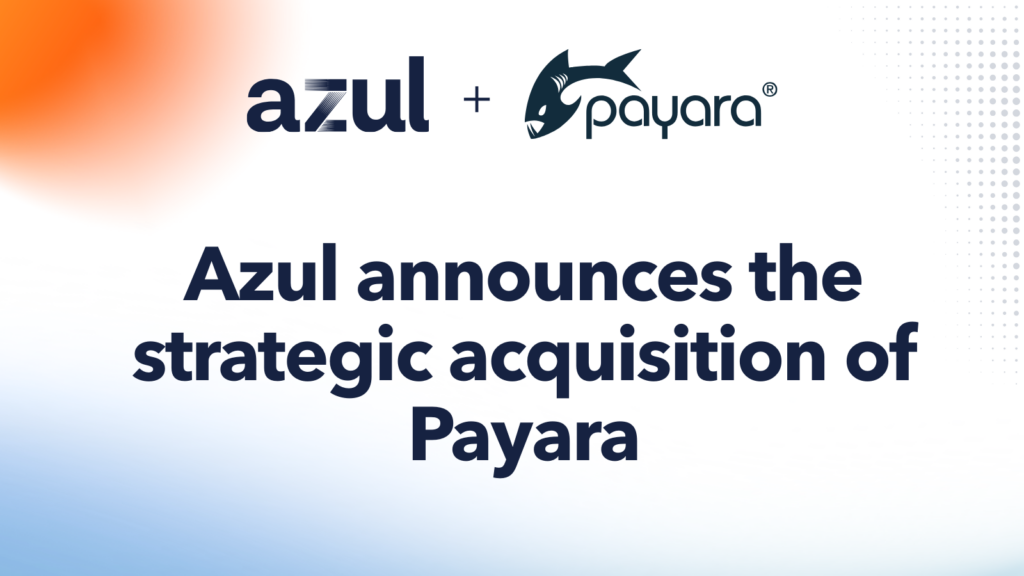 1 minute
1 minute
Scalable Enterprise Java for the Cloud
We’re excited to introduce Scalable Enterprise Java for the Cloud, a new free eBook created through a close collaboration […]

Having previously blogged about setting up data sources in Payara Server, we thought we should mention that you can also set up data sources in Payara Micro. In this blog, we’ll take you through the process of setting up a data source using Payara Micro, including code snippets and where to find full code examples. Let’s get started!
First, to use a database as a data source in Payara Micro, you’ll need to have the database already running. Once you have that in place, download the JDBC driver for the database and put it into your WEB-INF/lib directory.
In your web.xml add the following:
<data-source>
<name>java:global/ExampleDataSource</name>
<class-name>com.mysql.jdbc.jdbc2.optional.MysqlXADataSource</class-name>
<server-name>localhost</server-name>
<port-number>3306</port-number>
<database-name>mysql</database-name>
<user>root</user>
<password>root</password>
<!-- Example of how to use a Payara specific custom connection pool setting -->
<property>
<name>fish.payara.sql-trace-listeners</name>
<value>com.sun.gjc.util.SQLTraceLogger</value>
</property>
</data-source>
The class name is the name of the data source class for your database.
For Oracle DB:
<class-name>oracle.jdbc.pool.OracleDataSource</class-name>
For PostgreSQL:
<class-name>org.postgresql.ds.PGSimpleDataSource</class-name>
The database name must also be changed to the name of the database you are using i.e. Oracle or PostgreSQL.
Edit the user, password, server name and port number to match your database installation.
Environment variables, system properties and aliases are supported in the web.xml, so for example, instead of specifying localhost as the server name you could do the following:
<server-name>${server.name}</server-name>
These can be supplied to Payara Micro when starting it as -Dserver.name=localhost.
To use it in your code just use the following:
@Resource(name=”java:global/ExampleDataSource”)
DataSource ds;
A complete example is available on Github at: https://github.com/payara/Payara-Examples/tree/master/Payara-Micro/datasource-example
Why not give it a try? Payara Micro is the microservices-ready version of Payara Server. Less than 70MB in size, it requires no installation or configuration and no need for code rewrites – so you can build and deploy a fully working app within minutes.
Download Payara Micro
{{cta(‘4129273b-d6b4-4ef3-8fb7-412a2d0dfdfb’)}}
Share:
 1 minute
1 minute
We’re excited to introduce Scalable Enterprise Java for the Cloud, a new free eBook created through a close collaboration […]
 4 minutes
4 minutes
Strategic acquisition bolsters Azul’s Java platform with complementary products, deep Java expertise and accelerated go-to-market capabilities SUNNYVALE, Calif., and MALVERN, […]
 3 minutes
3 minutes
When legacy systems approach end-of-life (EOL), enterprise IT teams typically face the choice of moving forward at all costs […]
The link to Github is a bit incorrect, the right one would be https://github.com/payara/Payara-Examples/tree/master/payara-micro/datasource-example (notice there are no capital letters in “payara-micro”)
I prefer to configure a datasource and configure a persistence unit in the persistence.xml so that I won’t care about creating connections and adding more code because of it.
Why aren’t there any persistence.xml file? I want my data not to be coupled with my webApp. I want to have a persistence.xml in a separate jar and my webApp to make calls to this jar to get the data. Can you please explain or give an example? Thanks
If you wish to have a persistence.xml then you can have one, and have in the tag the JNDI of the resource defined in the web.xml as in this example, but the persistence must be in the same WAR as Payara Micro does not support other formats.
I’ve tested up this example using postgresql and it did not work. It Looks like to be an known issue https://github.com/payara/Payara/issues/1584.
I am sorry but I have not been able to reproduce that error. What version of Payara Micro are you using?
I am doing a simple database example with postgres datasource & it failing in payara micro at step:
code – Connection conn = ds.getConnection();
Earlier, DS is injected from @Resource i.e.
code – @Resource(name=”java:global/esWf”)
code – DataSource ds;
Database connection is working in test java code using:
code – Connection connection
= DriverManager.getConnection(“jdbc:postgresql://localhost:5432/postgres”, “user”, “pass@123”)
Also, payara REST is working without the database piece.
Datasource thing is new for me, and I might be missing out some minor step.
I have referred the git examples and researched several related blogs, but not able to solve this.
Here is the src and web folders: https://drive.google.com/file/d/1b3F74D1cby0sXuRhMqs9jjrp4e7lqbed/view?usp=sharing
Please see if you can check what might be issue.
Below is the null pointer error: –
java.lang.NullPointerException
at es.dms.DmsSrv.test(DmsSrv.java:65)
at sun.reflect.NativeMethodAccessorImpl.invoke0(Native Method)
at sun.reflect.NativeMethodAccessorImpl.invoke(NativeMethodAccessorImpl.java:62)
at sun.reflect.DelegatingMethodAccessorImpl.invoke(DelegatingMethodAccessorImpl.java:43)
at java.lang.reflect.Method.invoke(Method.java:498)
at org.glassfish.jersey.server.model.internal.ResourceMethodInvocationHandlerFactory.lambda$static$0(ResourceMethodInvocationHandlerFactory.java:52)
at org.glassfish.jersey.server.model.internal.AbstractJavaResourceMethodDispatcher$1.run(AbstractJavaResourceMethodDispatcher.java:124)
at org.glassfish.jersey.server.model.internal.AbstractJavaResourceMethodDispatcher.invoke(AbstractJavaResourceMethodDispatcher.java:167)
at org.glassfish.jersey.server.model.internal.JavaResourceMethodDispatcherProvider$ResponseOutInvoker.doDispatch(JavaResourceMethodDispatcherProvider.java:176)
at org.glassfish.jersey.server.model.internal.AbstractJavaResourceMethodDispatcher.dispatch(AbstractJavaResourceMethodDispatcher.java:79)
at org.glassfish.jersey.server.model.ResourceMethodInvoker.invoke(ResourceMethodInvoker.java:469)
at org.glassfish.jersey.server.model.ResourceMethodInvoker.apply(ResourceMethodInvoker.java:391)
at org.glassfish.jersey.server.model.ResourceMethodInvoker.apply(ResourceMethodInvoker.java:80)
at org.glassfish.jersey.server.ServerRuntime$1.run(ServerRuntime.java:253)
at org.glassfish.jersey.internal.Errors$1.call(Errors.java:248)
at org.glassfish.jersey.internal.Errors$1.call(Errors.java:244)
at org.glassfish.jersey.internal.Errors.process(Errors.java:292)
at org.glassfish.jersey.internal.Errors.process(Errors.java:274)
at org.glassfish.jersey.internal.Errors.process(Errors.java:244)
at org.glassfish.jersey.process.internal.RequestScope.runInScope(RequestScope.java:265)
at org.glassfish.jersey.server.ServerRuntime.process(ServerRuntime.java:232)
at org.glassfish.jersey.server.ApplicationHandler.handle(ApplicationHandler.java:680)
at org.glassfish.jersey.servlet.WebComponent.serviceImpl(WebComponent.java:394)
at org.glassfish.jersey.servlet.WebComponent.service(WebComponent.java:346)
at org.glassfish.jersey.servlet.ServletContainer.service(ServletContainer.java:366)
at org.glassfish.jersey.servlet.ServletContainer.service(ServletContainer.java:319)
at org.glassfish.jersey.servlet.ServletContainer.service(ServletContainer.java:205)
at org.apache.catalina.core.StandardWrapper.service(StandardWrapper.java:1636)
at org.apache.catalina.core.StandardWrapperValve.invoke(StandardWrapperValve.java:259)
at org.apache.catalina.core.StandardContextValve.invoke(StandardContextValve.java:161)
at org.apache.catalina.core.StandardPipeline.doInvoke(StandardPipeline.java:757)
at org.apache.catalina.core.StandardPipeline.invoke(StandardPipeline.java:577)
at com.sun.enterprise.web.WebPipeline.invoke(WebPipeline.java:99)
at org.apache.catalina.core.StandardHostValve.invoke(StandardHostValve.java:158)
at org.apache.catalina.connector.CoyoteAdapter.doService(CoyoteAdapter.java:371)
at org.apache.catalina.connector.CoyoteAdapter.service(CoyoteAdapter.java:238)
at com.sun.enterprise.v3.services.impl.ContainerMapper$HttpHandlerCallable.call(ContainerMapper.java:520)
at com.sun.enterprise.v3.services.impl.ContainerMapper.service(ContainerMapper.java:217)
at org.glassfish.grizzly.http.server.HttpHandler.runService(HttpHandler.java:182)
at org.glassfish.grizzly.http.server.HttpHandler.doHandle(HttpHandler.java:156)
at org.glassfish.grizzly.http.server.HttpServerFilter.handleRead(HttpServerFilter.java:218)
at org.glassfish.grizzly.filterchain.ExecutorResolver$9.execute(ExecutorResolver.java:95)
at org.glassfish.grizzly.filterchain.DefaultFilterChain.executeFilter(DefaultFilterChain.java:260)
at org.glassfish.grizzly.filterchain.DefaultFilterChain.executeChainPart(DefaultFilterChain.java:177)
at org.glassfish.grizzly.filterchain.DefaultFilterChain.execute(DefaultFilterChain.java:109)
at org.glassfish.grizzly.filterchain.DefaultFilterChain.process(DefaultFilterChain.java:88)
at org.glassfish.grizzly.ProcessorExecutor.execute(ProcessorExecutor.java:53)
at org.glassfish.grizzly.nio.transport.TCPNIOTransport.fireIOEvent(TCPNIOTransport.java:524)
at org.glassfish.grizzly.strategies.AbstractIOStrategy.fireIOEvent(AbstractIOStrategy.java:89)
at org.glassfish.grizzly.strategies.WorkerThreadIOStrategy.run0(WorkerThreadIOStrategy.java:94)
at org.glassfish.grizzly.strategies.WorkerThreadIOStrategy.access$100(WorkerThreadIOStrategy.java:33)
at org.glassfish.grizzly.strategies.WorkerThreadIOStrategy$WorkerThreadRunnable.run(WorkerThreadIOStrategy.java:114)
at org.glassfish.grizzly.threadpool.AbstractThreadPool$Worker.doWork(AbstractThreadPool.java:569)
at org.glassfish.grizzly.threadpool.AbstractThreadPool$Worker.run(AbstractThreadPool.java:549)
at java.lang.Thread.run(Thread.java:748)